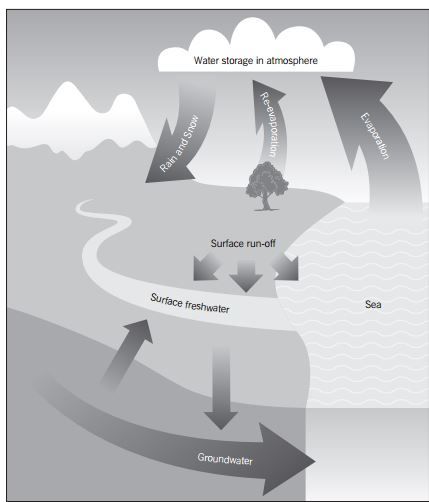Catchment-Based Activities
Water flows in a constant cycle from the ocean to the sky and back again, often via a landmass, where it picks up other substances along the way back to the sea. Various substances, from both natural and human-influenced processes, are discharged from the land and transferred to the coastal marine environment as part of the natural water cycle.
The cycle can be thought of as starting when the sun’s heat evaporates water from the oceans. The water vapour is carried along in air currents, which are forced up into cooler altitudes when they pass over a land mass. As the air cools, the water droplets condense and become visible as clouds. As the droplets become heavier, they eventually fall to the ground as rain (or snow).
Some rainwater is absorbed by plants and animals and is re-evaporated back into the atmosphere. Other rainwater flows back to the sea via streams, rivers, wetlands and estuaries (known generally as surface waters) taking with it dissolved material including nutrients and sometimes sediment. Yet other rainwater seeps down into underground rock and caves (known as groundwaters), where it may either flow underground to the sea, back up to join rivers or streams, or lie dormant underground. In addition, some rainwater falls onto urban areas where there are paved and other hard surfaces, and instead of percolating through the soil, it is collected in stormwater drains and carried into the sea.
Human activity has greatly affected the amounts and types of substances that are transferred by water from the land into the sea, with corresponding effects on the health of marine ecosystems. Human-derived substances, and excess amounts of natural materials, impact on the marine environment by upsetting natural balances and introducing foreign or toxic elements into the ecosystem. Deforestation and intensification of land use has been a significant contributor to this problem, as has the destruction of wetlands, because vegetation fulfils an important role of filtering contaminants from water. Wetlands act as enormous sponges which absorb excess water during times of heavy rainfall, allow sediment to settle out, process and trap nutrients, and then slowly discharge cleaner water into rivers and estuaries.
In order of decreasing impact, land-sources of increased sediment and contaminants in New Zealand’s marine environment are generated mainly from agriculture, urban sewage, urban stormwater, industrial waste, agricultural waste, mining and forestry. 7e8aea6c-5539-404f-976e-11422c62c45b

Catchment-sourced discharges can be divided into two types: point source and non-point source.
Point source discharges refer to contaminants that enter the catchment from a single defined source such as a sewage treatment plant or a milking shed. Non-point source pollution refers to contaminants that enter the catchment from multiple diffuse sources, such as contaminant in run-off from pasture or urban areas.
Point source pollution of this type has generally declined over the last 20-30 years as treatment system technology has been upgraded and alternative methods of disposal have been developed. However, at specific sites in New Zealand it can still be a problem.
Although pollution from point sources has declined in the last 30 years, contaminants from non-point sources continue to be a major problem for the health of New Zealand’s marine environment. Agricultural activities, forestry and urban earthworks can generate considerable quantities of sediment, and lead to an increase in the nutrient and microbial contaminants within sediment. Run-off from urban areas is another significant issue, including vehicle-derived zinc, copper and lead washed off roads and zinc from unpainted iron roofs.
Catchment-based activities include:
Pastoral Farming
Horticulture
Forestry
Urban stormwater
Industrial activities
Mining
Wastewater treatment
Septic tanks
-
Ministry for the Environment, 1997
Last updated at 2:11PM on February 25, 2015